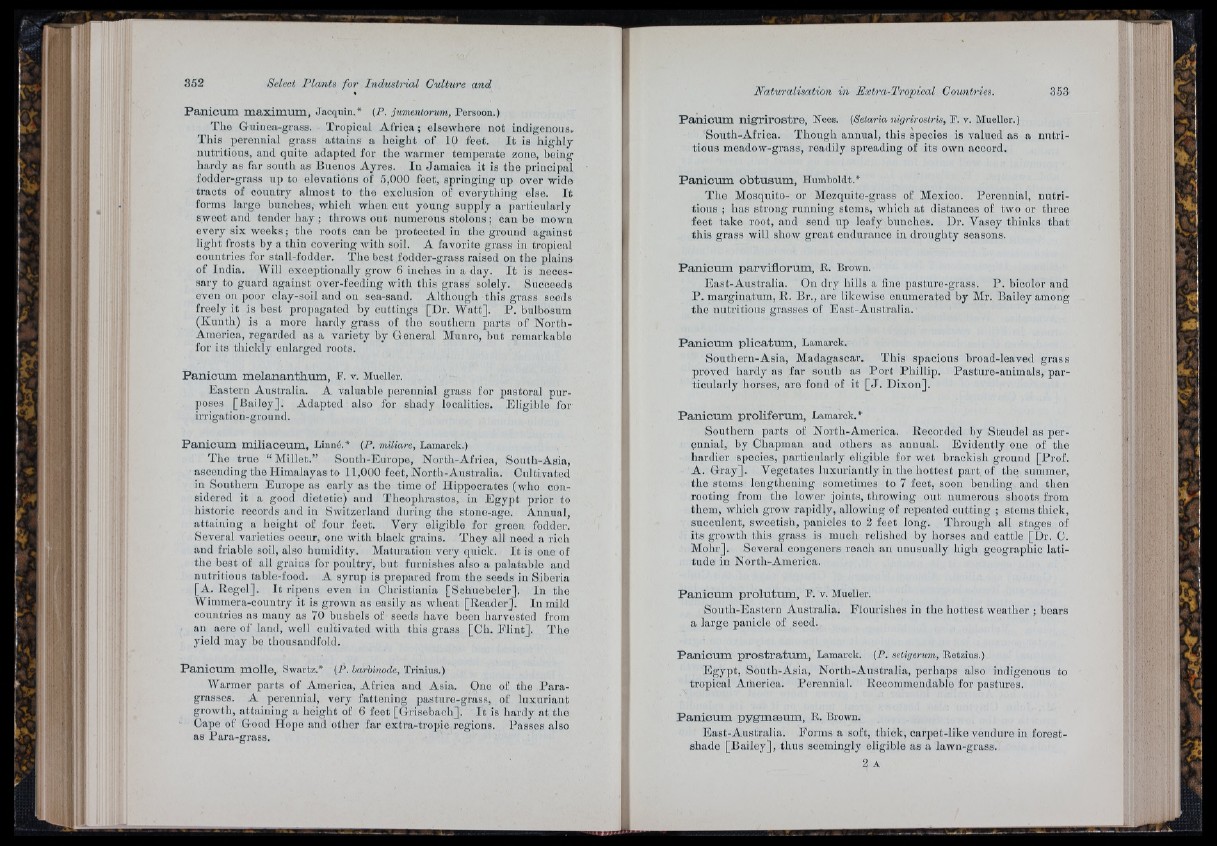
Select Plants for Industrial Culture and
Panicum maximum, Jacquin.* (P. jumentorum, I’craoon.)
Tlio Guiiioii-griiss. Tropical Africa ; olsowliore not indigeiioiis.
Tliis jieronnial grass attains a heiglit of 10 feet. I t is liiglily
nutritious, aud quito adapted for tho warmer temperate zone, being
liardy as far south as Buenos Ayres. Iu Jamaica it is tho jiriucipal
fodder-grass up to olovatioiis of 5,000 foet, springing up ovor wido
tracts of country almost to tbo exclusion of overytiiiug else. I t
forms largo buiichos, wliicli wlioii cut young supply a jiarticiilarly
sweet and tender hay ; throws out numerous stolons ; can bo mown
every six weeks ; tlio roots can bo jirotoctod in the groiiiid against
light frosts by a Ihin oovoriiig with soil. A favorite grass in tropical
countries for stall-fodder. Tlio best fodder-grass raised on tho jilaiiis
of India. Will oxcoptioiially grow 6 inches in a day. I t is iiocos-
sary to guard against ovor-focdiiig with this grass solely. Succeeds
ovoii oil poor clay-soil and ou searsaiid. Although this grass seeds
freely it is best projiagatod by cuttings [Dr. Watt]. P. biilliosiim
(Kiiiilli) is a more hardy grass of tlio soiitlioru parts of Nortli-
Amorica, regarded as a variety by General Munro, but remarkablo
for its thickly eiilargod roots.
Panicum melananthum, F. v. Muollcr.
Eastern Australia. A valuable poroiiiiial grass for pastoral purposes
[Bailey], Adapted also for shady localitios. Eligible for
irrigatiou-grouiid.
Panicum miliaceum, Linné.* (P. miliarc, X.amarck.)
Tlio true “ Millet.” Soutli-Eiiropo, Nortli-Afrioa, South-Asia,
ascending the Himalayas to 11,000 foot, North-Australia. Cultivated
ill Southorn Eurojio as oarly as tho tiiiio of Hijipocratos (who coii-
sidcrod it a good dietetic) and Tlieopiirastos, iu Egyjit jirior to
historic records and iu Switzerland diiriiig tlio stoiio-age. Annual,
attaining a height of four foot. Very oJigililo for groeii fodder.
Several varieties occur, ono with lilaek grains. They all need a rich
and I'riahie soil, also humidity. Maturation vory quick. I t is oiio of
tlio best of all grains for ¡loultry, but fiiriiishos also a palatable and
nutrllious tablo-food. A syrup is prepared from tlio seeds in Siberia
[A. Bogol]. It rijiens even iu Cliristiania [Scluiobolor]. In tho
Wimmera-couiitry it is grown as easily as wlioat [Reailor]. In mild
countries as many as 70 biisliois of soods have been liarvostod from
ail acre of laiiil, woll cultivated with this grass [Cli. Eliiit], The
yield may bo tlioiisaiidfold.
Panicum molle, Swartz.* (P. barUnode, ïrinina.)
Warmer parts of America, Africa and Asia. One ot tiio i ’ara-
grassos. A perennial, vory fattoiiiiig pasturo-grass, of luxuriant
growtli, attaining a lieiglit of 6 feot [Gi'isebacli]. I t is liardy at tlio
Capo of Good Ilopo and other far extra-tropic regions. I’asscs also
as Para-grass.
Panicum nigrirostre, Noos. (Setaria myriro.drù, P. v. Mueller.)
Sontli-Al'rica. Tliougli aniiual, this species is valued aa a nutritious
meadow-grass, readily sjireadiug of its own accord.
Panicum obtusum, Humboldt.*
The Mosquito- or Mezquito-grass of Mexico, i ’oreiinial, nutritious
; lias strong rniiiiiiig stems, wliicli at distances ot two or tliroe
foot take root, and send up loiify bunches. Dr. Vasey tliiiiks tliat
this grass will sliow groat cudurauoo in droughty seasons.
Panicum parviflorum, R. Brown.
East-Australia. On dry bills a fino pasturo-grass. P . bicolor aud
P. niargiiiatum, R. Br., are likowlso onuuieratod by Mr. Hailey among
tlic nutritious grasses of East-Australia.
Panicum plicatum, Lnmarck.
Soiitlicrn-Asia, Madagascar. Tliis spacious broad-leaved grass
proved liardy as far south as Port Pliiilip. Pastiiro-aiiiinals, par-
ticiilaiiy horsos, aro fond of it [ J . Dixon].
Panicum proliferum, Lamarck.*
Soutliern parts of Nortli-America. Recorded by Steudel as per-
piinial, by Cliapinaii aud others as annual. Evidoiilly one of tlio
hardier spocios, paiiiciilaiiy eligible for wet brackish ground [Prof.
A. Gray]. Vegetates liixiiriautly iu tlio liottost part of tliq siimiuor,
the stems loiigtlioiiliig sometimes to 7 feet, soon bonding and tlion
rooting from tlio lower joints, tlirowiiig out iiiiiiierous slioots from
them, wliicli grow rapidly, allowing of rojicated cutting ; stems tliick,
sueculoiit, swoetisli, iiaiiicles to 2 feet long. Tlirough all stages of
its grow'th this grass is mucli rolislicd by liorsos and cattio [Dr. C.
Molir]. Several congeners roaoli an unusually liigii geograpliic latitudo
iu North-Aiiicrica.
Panicum prolutum, F. v. Muelicr.
Soutli-Eastcrii Australia. Flourislios iu the hottest weather
a largo panicle of seed.
bears
Panicum prostratum, Lamarck. (P. seligerum, Retzius.)
Egyjit, Soiitli-Asia, Nortli-Aiistralia, pciiiaps also iudigonous to
tropical Aiiiorica. Poronnial. Rocommoiidablo for pastures.
Panicum pygmaaum, H. Ihwn.
East-Australia. Forms a soft, tliiok, carpot-liko vondiiro in forost-
slmdo [Bailey], thus soomingiy eligible as a lawn-grass.
2 A
I;' ■ ■